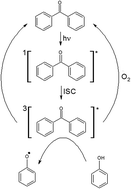An experimental methodology to measure the reaction rate constants of processes sensitised by the triplet state of 4-carboxybenzophenone as a proxy of the triplet states of chromophoric dissolved organic matter, under steady-state irradiation conditions†
Abstract
By a combination of transient absorption spectroscopy and steady-state irradiation experiments, we investigated the transformation of phenol and furfuryl alcohol (FFA) sensitised by irradiated 4-carboxybenzophenone (CBBP). The latter is a reasonable proxy molecule to assess the reactivity of the excited triplet states of the chromophoric dissolved organic matter that occurs in natural waters. The main reactive species for the transformation of both phenol and FFA was the CBBP triplet state, despite the fact that FFA is a commonly used probe for 1O2. In the case of FFA it was possible to develop a simple kinetic model that fitted well the experimental data obtained by steady-state irradiation, in a wide range of FFA concentration values. In the case of phenol the model was made much more complex by the likely occurrence of back reactions between radical species (e.g., phenoxyl and superoxide). This problem can be tackled by considering only the experimental data at low phenol concentration, where the degradation rate increases linearly with concentration. We do not recommend the use of 1O2 scavengers/quenchers such as sodium azide to elucidate CBBP photoreaction pathways, because the azide provides misleading results by also acting as a triplet-state quencher. Based on the experimental data, we propose a methodology for the measurement of the CBBP triplet-sensitisation rate constants from steady-state irradiation experiments, allowing for a better assessment of the triplet-sensitised degradation of emerging contaminants.

- This article is part of the themed collection: Best Papers 2018 – Environmental Science: Processes & Impacts


 Please wait while we load your content...
Please wait while we load your content...